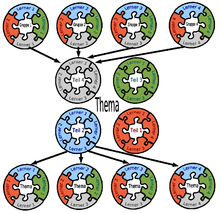Group puzzle
The group puzzle , according to the American model also Jigsaw method ( English Jigsaw Teaching Technique ), is a form of group work . The members of a class or a seminar are divided into groups. Each group works on the overall topic, but each member works individually on a different part. Then all the “experts” of a sub-area meet to compare their results. The experts then return to their home group to present their specialty to the other group members. Finally, the overall topic is checked for all group members. In the first step, it is necessary to work independently on the material. In the expert groups, differences in quality in individual work are balanced out. In the third phase, the group members must listen carefully to the presenter, encourage and support him. This prevents the other group members from being perceived as competitors.
The Jigsaw method was developed by Elliot Aronson in Austin, Texas in 1971 to solve problems between students of different origins ( African-American , white , Latino ) who were taught together for the first time after the segregation was abolished . In doing so, he built on the “Robber's Cave Experiment” by Muzafer Sherif .
advantages
- Prejudices are broken down
- the self-confidence is strengthened
- the school and learning climate is improved
- the truancy is reduced
- Responsibility is learned etc .; to this end, it pursues the goals of cooperative learning .
method
- Divide the class into groups of five or six people. The members should be mixed in terms of gender, origin and skills.
- Appoint one leader per group.
- Divide the subject matter into five to six subtasks beforehand.
- Assign a task to each member of a group. Each member of the group becomes an “expert” in an area.
- Allow members time to familiarize themselves with their field.
- Form “expert groups” in which members of the same sub-area meet and compare their findings.
- Let the "experts" return to their original group.
- Experts convey to the other group members what they have worked out on their specialist areas.
- Teacher moves from group to group to see progress.
- Create a quiz on the subject matter.
Problems that may arise with this method:
- The interfaces between the collective work phase and individual learning steps must be well planned so that there is no unrest and as little time as possible passes inefficiently.
- Not all students work equally quickly: So additional materials should be prepared and available for the quick ones.
literature
- E. Aronson (1978). The jigsaw classroom . Beverly Hills: Sage
- E. Aronson, S. Patnoe (1997). Cooperation in the classroom: The jigsaw method . New York: Longman
- E. Aronson (2000). Nobody left to hate . New York: Henry Holt
Web links
- The Jigsaw Classroom. Retrieved March 31, 2015 (English, website on the subject designed by Social Psychology Network and Elliot Aronson).
- Short version of the teacher training course BW
- Group puzzle in the ZUM wiki
- In Kersten Reich's pool of methods, the method is explained in great detail under the Group Expert Rally. Other procedures are also described under Group Competition Rally.
